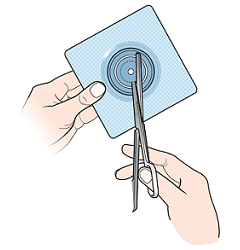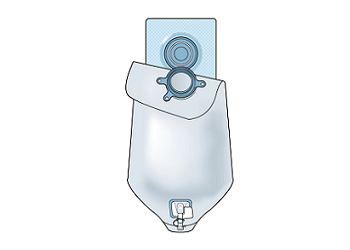This information will help you change your disposable urostomy pouching (bag) system after you’re discharged from the hospital. A urostomy pouching system is sometimes called a urostomy appliance.
For more information about your urostomy and caring for your urostomy pouching (bag) system, read the resource About Your Urostomy. You can also watch the video How to Change Your Urostomy Pouching System at Home.
Changing Your Pouching (Bag) System
Your pouching (bag) system includes a wafer (the part that sticks to your skin) and a pouch (the part that holds your urine). You may be using a 2-piece system, where the wafer and pouch are separate, or a 1-piece system, where the wafer and pouch are attached.
You should change your pouching system every 3 to 4 days. It’s best to change it in the morning before you eat or drink anything, when there’s less urine (pee) coming from your stoma. If your pouching system is leaking, change it right away.
You can change your pouching system wherever you’re most comfortable. You can do it either sitting down or standing up. Most people like to change it in the bathroom in front of the mirror. You can also remove your pouching system and clean around your stoma as part of your shower or bath routine.
Supplies
Gather your supplies before you start. You will need:
- Adhesive remover spray or pads
- Gauze pads, paper towels, or clean washcloths
- Measuring guide
- Pen or marker
- Scissors (if you’re using a cut-to-fit wafer)
- New pouching (bag) system
You should also gather any extra supplies you’re using, such as:
- Mirror (for a better view of your movements)
- Blow dryer or handheld fan
- Thin hydrocolloid sheet
- Liquid skin protectant
- Thin barrier ring
- Elastic barrier strips
- Urostomy belt
Instructions
-
Clean your hands.
- If you’re using soap and water, wet your hands and apply soap. Rub your hands together thoroughly for 15 seconds, then rinse. Dry your hands with a disposable towel. Use that same towel to turn off the faucet.
- If you’re using an alcohol-based hand sanitizer, cover all of your hands with it. Rub your hands together until they’re dry.
-
Empty your pouch (bag).
- Open the spout at the bottom of your pouch by flipping the tab so the red line is showing. This will let the urine run out of the pouch. You can remember this wit the phrase “red means running.”
- Make sure you do this over a toilet to catch the urine. You can put a piece of toilet paper in the toilet first to keep the urine from splashing.
- Once the pouch is empty, wipe it with toilet paper and close it so no more urine runs out.
- Clean your hands. Follow the instructions in step 1.
-
Take your pouching system off. Remove the wafer and pouch together.
- Spray adhesive remover spray over the wafer.
- Press down on your skin with one hand. With your other hand, gently lift an edge of the wafer and roll it away from your skin. Don’t pull the wafer straight away from your skin. The skin around your stoma is sensitive, so it’s important to be gentle. Spray more adhesive remover spray under the wafer as you go.
- Once you’ve removed the pouching system, throw it in the trash.
-
After you remove the pouching system, hold a dry piece of gauze, paper towel, or washcloth over your stoma opening. This will keep urine from leaking out. Change it if it gets soaked with urine.
- If you’re removing your pouching system in the shower, you don’t need to do this. The urine will flow down the shower drain.
- Many people enjoy leaving their skin uncovered for 15 to 30 minutes after removing the pouching system. This is called a skin break. You can decide if you want to take a skin break. If you do take a skin break, you can hold a towel, urinal, or other container over your stoma to catch the urine that leaks out.
-
Clean and dry the skin around your stoma.
- Moisten a piece of gauze, paper towel, or washcloth. Use it to gently clean the skin around your stoma. Don’t use any soap.
- Dry the skin around your stoma. You can use a blow dryer on the “cool” setting or a handheld fan, or you can pat your skin dry with a dry gauze, paper towel, or clean towel.
-
Make sure the area is completely dry. Your skin shouldn’t be sticky.
-
Measure your stoma size.
- Your stoma will slowly get smaller over the first 6 to 8 weeks after your surgery. During this time, use a measuring guide to measure your stoma and fit the wafer every time you change your pouching system. Once your stoma reaches its permanent size, you can start using a pre-cut wafer.
- If your stoma is round, use the measuring guide to measure your stoma. Compare the holes in the measuring guide to the size of your stoma. Choose the hole that fits exactly around your stoma with no gaps.
- If your stoma isn’t round, measure the vertical side, then the horizontal side.
-
Get the new pouching system ready.
-
Place the measuring guide over the back of the wafer (the side that will go against your skin). Use the measuring guide to mold or cut the wafer to the exact size you need. Some wafers have lines to help you. You can also trace the correct size onto the back of the wafer. Check the wafer against your stoma to make sure it’s the right size.
- If you’re using a moldable wafer, turn the wafer over so you’re looking at the front (the side that will face away from your skin). Gently roll back the opening and press down for a few seconds to keep it from rolling back too much.
- If you’re using a cut-to-fit wafer, remember to start cutting at the center hole (see Figure 1).
- If you’re using a two-piece system, snap the wafer and pouch together (see Figure 2). Give it a small tug to make sure it’s secure.
-
Check the tab at the bottom to make sure the pouch is closed.

Figure 1. Cutting the wafer

Figure 2. Attaching the pouch to the wafer
-
Place the measuring guide over the back of the wafer (the side that will go against your skin). Use the measuring guide to mold or cut the wafer to the exact size you need. Some wafers have lines to help you. You can also trace the correct size onto the back of the wafer. Check the wafer against your stoma to make sure it’s the right size.
-
Get the skin around your stoma ready.
- If any urine leaked from your stoma while you were getting the pouching system ready, clean the area. Follow the instructions in step 5.
- If the skin around your stoma is irritated or very red, apply a thin hydrocolloid protective sheet or liquid skin protectant.
- If you’re using a thin barrier ring, peel the backing from both sides. Stretch the barrier ring to fit over your stoma and gently press it onto your skin. It should be right against your stoma, without any gaps.
-
Apply the pouching system.
- Peel the backing off the wafer and place it over your stoma. It may help to use the mirror. Make sure the wafer is against your skin at the base of your stoma.
- Place your hand over the wafer. The warmth of your hand will help it stick to your skin. Follow the manufacturer’s instructions for how long to leave your hand there. Usually, it’s 5 to 10 minutes.
-
Apply any accessory products you’re using.
- If you’re using elastic barrier strips, peel the backing from the strips and place them over the wafer, close to the center. It’s okay if a small part is on your skin, but try not to have too much on your skin. This can cause irritation.
- If you’re using a urostomy belt, attach it to the tabs on the pouching system. Hook the belt to one side of the pouching system, wrap it around your waist, then hook it to the other side. Adjust it so it fits snugly.
- Clean your hands. Follow the instructions in step 1.
The Skin Around Your Stoma
While you’re changing your pouching (bag) system, look at the color of your stoma and the skin around it. Your stoma should be red or pinkish-red, like the color inside your mouth. If it’s any other color, like brown, gray, or black, take a picture and send it to your doctor using your MyMSK account and call your doctor after you finish changing your pouching system. You might find it helpful to follow the instructions in the resource Tips for Taking Pictures to Share with Your Healthcare Provider.
The skin around your stoma may be slightly pink (if you have lighter skin) or gray-brown (if you have darker skin). This is from the pressure of the wafer and doesn’t mean your skin is irritated. Your skin should go back to its normal color if you leave it uncovered for about 15 to 30 minutes.
Caring for Irritated Skin
Irritated skin will look bright red, not pink. You may also feel burning, itching, or pain in the area. If you think your skin is irritated, take a picture and send it to your doctor using your MyMSK account and call your doctor after you finish changing your pouching (bag) system. You can also follow the instructions in the resource How to Manage Skin Irritation Around Your Urostomy Stoma.
